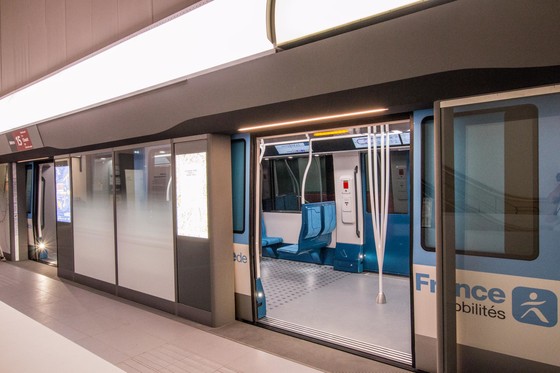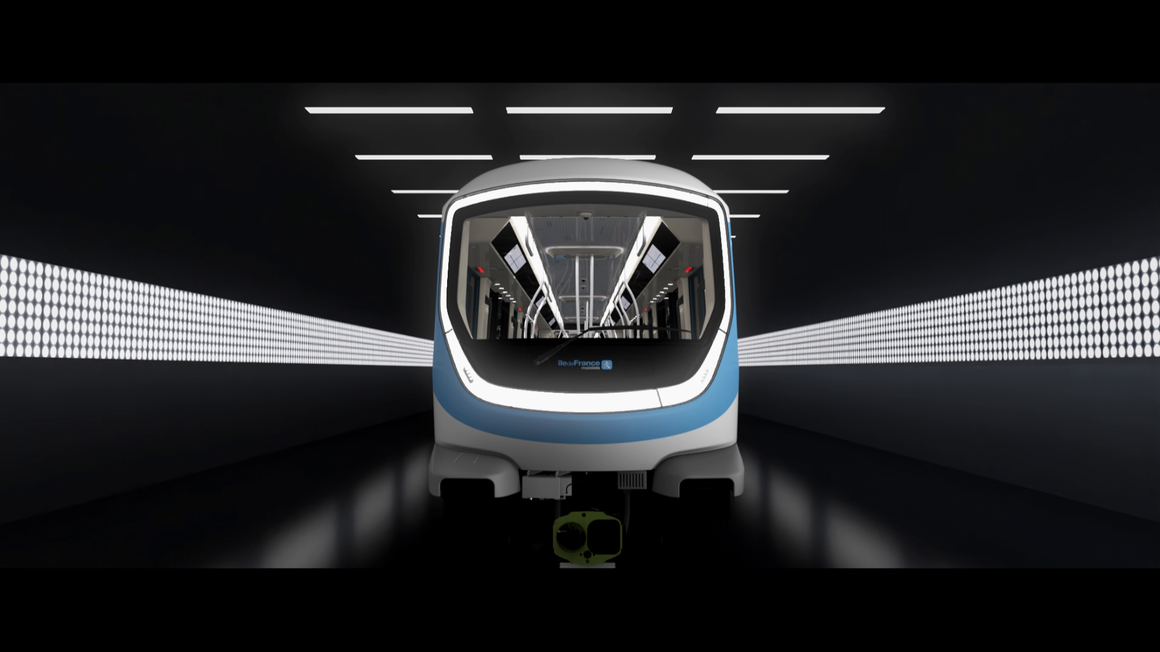
Design of the future metros for lines 15, 16 and 17 of Île-de-France revealed by Île-de-France Mobilités, Société du Grand Paris and Alstom
Design of the future metros for lines 15, 16 and 17 of Île-de-France revealed by Île-de-France Mobilités, Société du Grand Paris and Alstom

On Friday 2 October 2020, Valérie Pécresse, President of Île-de-France Mobilités and of the Île-de-France Region, Thierry Dallard, Chairman of the Management Board of the Société du Grand Paris, and Henri Poupart-Lafarge, Chairman and CEO of Alstom, revealed the design of the future metros for lines 15, 16 and 17 of Île-de-France at the inauguration of the exhibition Les lignes du design (Design Lines) which opens at the Fabrique du Métro where visitors will be able to see a model of the future metro.
“Île-de-France Mobilités has made very specific requests for metros on the new Île-de-France region metro line (15, 16, 17): passenger comfort including air conditioning, a peaceful atmosphere, clear, accessible information, and optimal safety. This initial 1:1-scale model in the colours of Île-de-France Mobilités gives a stunning idea of the new metros that will be delivered by Alstom following monumental works by the Société du Grand Paris. I am certain that if their technical performance is as successful as their design, Île-de-France region passengers will be especially proud of their metro.”
Valérie Pécresse, President of the Île-de-France Region and President of Île-de-France Mobilités
"We are very pleased to be able to reveal, with our partners Île-de-France Mobilités and Alstom, a full-scale mock-up of a metro car from the Grand Paris Express, which will allow future users to discover the new metro on a site open to everyone, the Fabrique du Métro. The exhibition "Les lignes du design" is a preview of what a journey on the Grand Paris Express will be like, from arrival in the station right up to the journey in the metro as of 2024. This new metro will be environmentally friendly, accessible to all, fast, reliable and comfortable, which is what's expected of a means of transport today."
Thierry Dallard, Chairman of the Management Board of the Société du Grand Paris
"Two years after signing the rolling stock contract for lines 15, 16 and 17, we are proud and happy to present, alongside our partners, Île-de-France Mobilités and Société du Grand Paris, the design of this future metro. This phase concludes two years of engineering work just as we are launching the production of the metro. We have designed and will produce a state-of-the-art metro that benefits from the latest technologies, offering high performance and a renewed passenger experience."
Henri Poupart-Lafarge, Chairman and CEO of Alstom
Lines 15, 16 and 17 will be equipped with state-of-the-art driverless automatic metros developed from solutions from Alstom's Metropolis range. These metros will guarantee the highest levels of availability, reliability and safety expected by passengers. With cars 2.8m wide, each metro will be able to carry approximately 500 passengers in its 3-car version and around 1,000 passengers in its 6-car version. Commercial speed will be between 55 and 65 km/h with peak speeds of up to 110 km/h. The automatic train operation will ensure travel comfort, with acceleration and braking controlled by automated driving systems combined with an efficient suspension system.
In collaboration with Île-de-France Mobilités, the Société du Grand Paris, its prime contractor Systra and its design agency RCP Design Global, and taking the expectations of public transport users into account, Alstom's Design&Styling office has created an interior design that offers a fluid, comfortable passenger journey. The interior layout of the metros is designed to be both high in capacity and comfortable.
With very wide interior circulation and a variety of grip fixtures, passengers can move around easily and choose the space that suits them. The design of the front end offers passengers a new comfort zone and a panoramic view thanks to a very wide windscreen, a panoramic console, and seating on both sides. The seats are comfortable with high backrests, wide legroom, isolating armrests, a transversal layout (solo seats and face-to-face duos) and a longitudinal layout (bench-style) to encourage passenger circulation on board the train and enhance the sensation of fluidity and space. Standing travel is also more comfortable with ischiatic supports at the rear of the seats and in the mixed areas, ergonomic hand holds, and circulation areas treated like travel spaces. Passengers in wheelchairs and people with children in pushchairs or with large suitcases are easily accommodated with two zones dedicated to wheelchair users per train and mixed spaces in each car. The priority seats are numerous and easy to identify by their specific colour.
The journey is also pleasant with the sensation of an enlarged space, thanks to clean-cut shapes associated with light colours, and lighting resembling natural light which varies according to the time of day, adjusting to the biological rhythm of the passengers to improve well-being. For greater comfort and safety, the metro is accessed underneath reinforced lighting on the platform and on the vehicle threshold. The spaces under the seats are completely unobstructed and equipped with lighting, which reinforces the feeling of security. Information is always within the passenger's reach, via screens grouped together in a continuous strip throughout the entire metro. USB sockets for charging phones and tablets are also provided. Each car is equipped with powerful ventilation, air conditioning and heating systems to ensure thermal comfort in all seasons.
The metro's environmental performance is guaranteed by a number of innovations. 100% electric service braking, a system for recovering the energy generated by braking and the widespread use of LED lighting will help to optimise electricity consumption. The use of electric braking will limit particle emissions. The rolling stock will be more than 98% recyclable.
Finally, particular attention has been paid to optimising the maintenance of the new metro. The on-board diagnostic system will pass on information about the condition of the train equipment and give maintenance staff a complete overview of the condition of the fleet, making it easier to plan corrective and predictive maintenance tasks. These new metros will meet demands to optimise maintenance operations with the aim of reducing maintenance costs over the entire life cycle.
This rolling stock project, financed entirely by Île-de-France Mobilités, contributes actively to the solidity of the rail sector and its foothold in France. 350 Alstom employees at eight sites in France, including 150 engineers, will work on this project. The project will also provide 800 jobs for French suppliers. In total, around 1,150 jobs will be secured within the French rail industry.